Chapter 21
Colonel Peter J. Ortiz
An OSS Marine in Europe
By Jonathan Bernstein, Arms and Armor Curator
Featured artifacts: Medal, Navy Cross (2011.5.1); Medal, Legion of Merit (2011.5.2); Medal, Purple Heart (2011.5.3); Medal, British, Order of the British Empire (2011.5.5); Insignia, Cap, Eagle, Globe, and Anchor (2011.5.12); Insignia, Rank, Collar, Colonel (2011.5.13 a-b); Insignia, Basic Parachutist (2011.5.14); Insignia, Special Force Wing, OSS (2011.5.16); and Medal, Prisoner of War (USA) (2011.5.27)
Since the end of World War II, the island-hopping campaigns in the Pacific theater have become synonymous with the U.S. Marine Corps experience in that conflict. Yet oddly enough, one of the Marines’ most decorated officers never set foot in the Pacific theater. Nothing about his career was “standard,” so it is unsurprising that Colonel Peter J. Ortiz would be among a handful of Marines that fought in Europe and North Africa. His exploits would become legendary in both Marine Corps and Hollywood history.
By the time he enlisted in the Marine Corps in June 1942, Ortiz already had a significant amount of combat experience on two continents. Although he was born in the United States, he was raised in France by an American mother and a French father. At age 19, looking for some excitement and a relief from his studies, he enlisted for a five-year tour with the French Foreign Legion, much to his parents’ dismay.
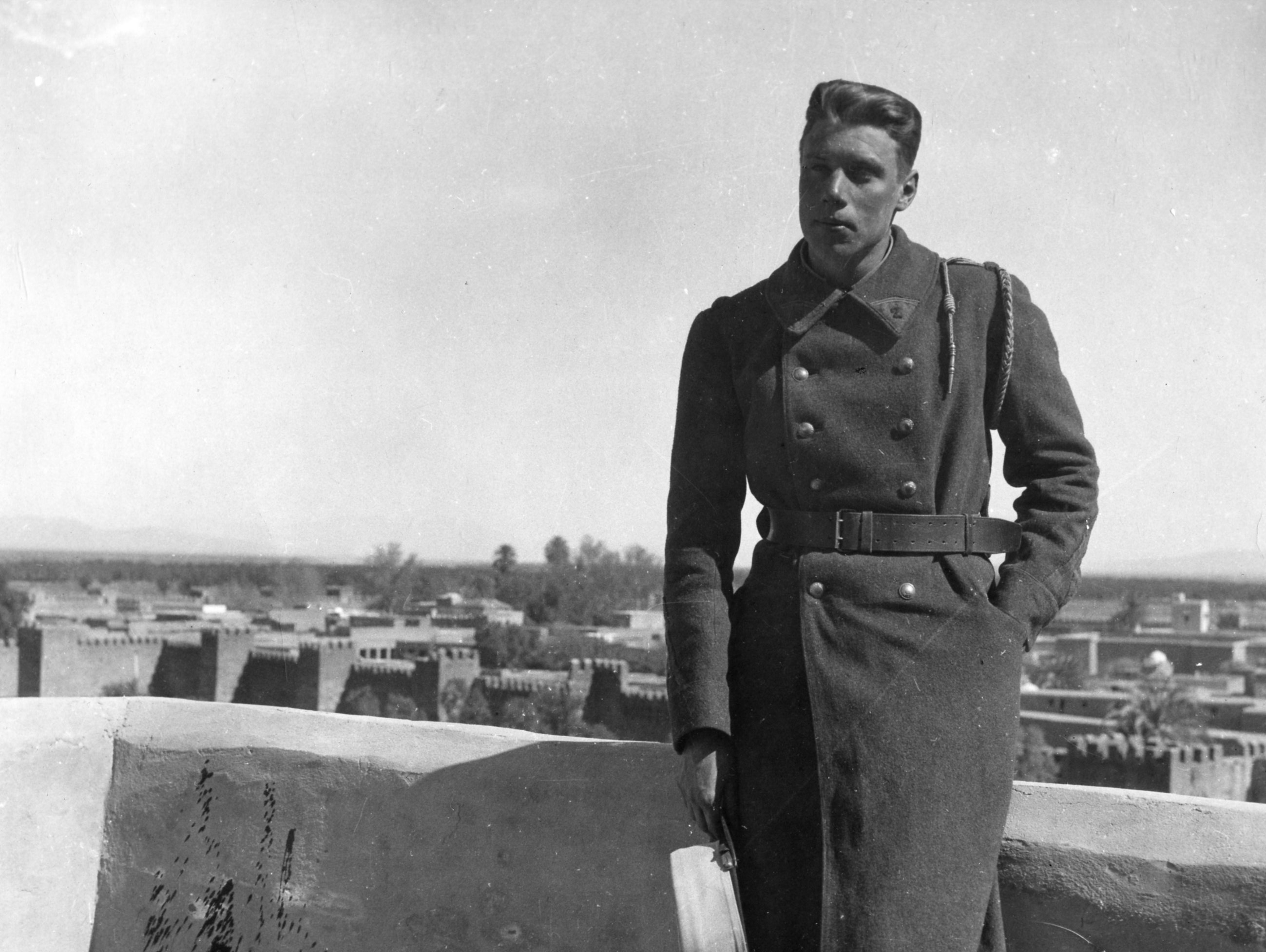
It is unclear exactly when this photograph was taken, but it was taken in Algeria during Peter Ortiz’s first stint with the French Foreign Legion.
Marine Corps History Division.
Ortiz excelled in the Foreign Legion and was promoted quickly. He spent most of his time in French Morocco, where he absorbed the region’s language and culture to better understand his surroundings and his enemy, since the Legion was regularly engaging groups of bandits. By the end of his five-year enlistment, he was commanding an armored car squadron as a sergeant. The Legion wanted to keep him on and offered him a commission to stay.
Ortiz had other plans, however, and in 1937 made his way to the United States to see his mother in California and to try to break into Hollywood as a technical advisor on war films. This proved a more challenging task than he had realized. He had some limited successes, and he was able to build several relationships with Hollywood “movers and shakers” that would benefit him later in life. But by the end of the following year, he was looking back toward the military and the thrill of combat. He soon headed back to France to rejoin the French Foreign Legion in the face of the looming Nazi German threat.
Following the German invasion of Poland and the subsequent declarations of war on Germany by France and the United Kingdom in September 1939, Ortiz attempted to find passage to France several times, finally arriving in mid-October. He rejoined the French Army as a sergeant in the newly raised 11th Foreign Infantry Regiment (11e Régiment Étranger d’Infanterie, or REI) and participated in the early campaign against Germany on the Western front. During this phase, the 11th REI was primarily in defensive positions near the city of Thionville, where aggressive patrolling at the squad and platoon level was the primary method of engagement against the Germans. Ortiz was quickly recognized for his leadership and skill in leading such patrols and was awarded a battlefield commission in May 1940, just in time for the German invasion of France.
With his technical and mechanical expertise, Ortiz was given command of the regiment’s motorcycle platoon, with which he led numerous hit-and-run raids against the enemy and critical scouting missions.[1] The 11th REI would bear the brunt of the German assault on Bois d’Inor in late May 1940, holding the line against the German 56th Infantry Division’s onslaught.
In the face of the overwhelming German blitzkrieg, the 11th REI replenished its losses in the early weeks of June 1940 and moved south to the town of Saint-Germain-sur-Meuse. As the French forces staged their last desperate gambits against the advancing German forces, Ortiz fought valiantly while “the 11th stood fast as a rock against the German tide of invasion that rolled around it. The 11th Regiment fought until it was engulfed!”[2] Just before his capture, Ortiz was gravely wounded while attempting to destroy a fuel dump, leaving him partially paralyzed from the waist down due to shrapnel in his spine.
Ortiz spent the next 15 months as a prisoner of war in various prison camps in Austria and Germany, where he recovered through the efforts of a German surgeon. During that time, he became a constant nuisance to his captors, who labeled him as “dangerous.” He attempted to escape a few times, finally succeeding in October 1941. Once free, he carefully made his way to Portugal, arriving two months later and boarding a ship bound for the United States.
Arriving in the United States less than a week after the Japanese attack on Pearl Harbor, Hawaii, Ortiz immediately attempted to brief the U.S. Army on his knowledge of the situation in France, including how he escaped his captivity, and offered his services to the U.S. military. The U.S. Army Air Forces (USAAF) intelligence section tentatively offered him a commission, but after bureaucratic red tape ground the process to a halt, Ortiz decided to head west to California to rest and regain his strength at his mother’s house. Six months later, after hearing nothing further from the
USAAF, Ortiz enlisted in the Marine Corps on 22 June 1942.
From the start, Ortiz was a standout recruit. During his 10 weeks of boot camp at Parris Island, South Carolina, he made his experience and discipline readily apparent. He enjoyed the training, although he made it clear that his experience training as a member of the French Foreign Legion had been more difficult. At his graduation, Ortiz wore all his French military awards that he had earned during his two tours with the Foreign Legion, which garnered him a great deal of attention. Colonel Louis R. Jones, the chief of staff at Parris Island, wrote to Lieutenant General Thomas Holcomb, the Commandant of the Marine Corps, recommending Ortiz for a commission:
Private Ortiz had made an extremely favorable impression upon the undersigned. His knowledge of military matters is far beyond that of the normal recruit instructor. Ortiz is a very well set up man and makes an excellent appearance. The undersigned is glad to recommend Ortiz for a commission in the Marine Corps Reserve and is of the opinion that he would be a decided addition to the Reserve Officer list. In my opinion he has the mental, moral, professional, and physical qualifications for the office for which he has made application.[3]
Ortiz accepted an officer’s commission and pinned his lieutenant’s bars on his uniform on 1 August 1942. He was assigned to Company D, 1st Battalion, 23d Marines, at Marine Corps Base Camp Lejeune, North Carolina, and shortly after arriving there he requested to attend the Marine Corps parachutist course, since he had already completed French parachute training during his second tour with the Foreign Legion. However, the Office of Strategic Services (OSS), the forerunner of today’s Central Intelligence Agency, took great interest in Lieutenant Ortiz’s unique qualifications and requested him on loan from the Marine Corps. In a letter to Lieutenant General Holcomb, written a week after Operation Torch, the Allied invasion of North Africa in November 1942, Colonel Keller E. Rockey stated, “The rather unique experiences and qualifications of Lieutenant Ortiz indicate that he would be of exceptional value to American units operating in North Africa.”[4]
Indeed, Ortiz’s experiences in Morocco, his fluency in French, German, and Arabic and his aggressive spirit made him an ideal candidate to conduct operations for the OSS in North Africa. He was promoted to captain on 3 December 1942 and was on a ship to Tangiers, Morocco, by the end of the month. Officially, he was assigned to the naval attaché’s office, but he was tasked with developing the U.S. Western Task Force’s reconnaissance plan and leading reconnaissance teams behind German lines to gather intelligence.
Ortiz quickly set about getting to know the locals and built a reconnaissance team that was able to blend in with the local populace and operate with near invisibility far into German-held Tunisia. During one such mission, he and his team were caught by U.S. soldiers as they crossed back into friendly territory and were presumed to be spies. Ortiz, wearing his Marine utilities under his local garb, was initially unable to convince the soldiers that he was an American. After all, why would a U.S. Marine be in North Africa?
In late March 1943, Ortiz led another reconnaissance patrol into German territory and ran into a German patrol. During the ensuing firefight, he was shot in the hand and wounded badly but held his position, ultimately fighting off the German patrol by throwing hand grenades to force them back. His team got him back to Allied lines, and he subsequently spent some time in a hospital in Algiers, Algeria, recovering from his wounds, where he was awarded his first Purple Heart. Due to his successes in building the reconnaissance capabilities for Allied forces in North Africa, Ortiz was recalled to OSS headquarters in Washington, DC, a few weeks later to begin planning for operations in France the following year.
At that time, the OSS Special Operations branch was coordinating with the British Special Operations Executive (SOE) to create a joint team to support covert action in occupied France. The team was code named “Union.” According to the OSS, “Once dropped into an occupied area, [special operations] personnel linked up with resistance groups, identified their operational needs, arranged drop zones, and then radioed for supply drops.”[5]
On the faintly moonlit night of 6 January 1944, Union boarded a black-painted Handley Page Halifax bomber from the British Royal Air Force’s (RAF) No. 138 Squadron at Tempsford airfield north of London. The airplane, commanded by Warrant Officer Pick, lifted off at 2012 and turned southeast towards France.[6] The mission, codenamed “John 38,” was to insert the three-person team (one British, one American, and one French) near Vercors in southeastern France to help organize the French Resistance and establish a regular supply chain. The nearly three-hour flight would be accomplished at low level, with the Union team jumping at the minimum allowable height for their parachutes to open. Three other teams were intended to be inserted into France that night, but two were forced to turn back without dropping due to lack of contact on the ground. The RAF aircrew carrying Ortiz and his team successfully made contact, and the operatives dropped in without incident.
Once on the ground, Ortiz’s next adventure was well underway. Since the team had been assembled and trained under British SOE procedures, all three operatives had jumped in civilian clothes, per SOE practice. However, each had his uniform packed in his equipment bag to properly identify him as a member of the military and not as a spy.
During this mission, Ortiz gained a reputation for wearing his Marine Corps officer’s service uniform, complete ribbons and insignia, while training with the French Resistance, or Maquis. The German occupiers were aware of his presence and had heard rumors of a U.S. Marine officer and his uniform. One encounter particularly stands out, and there are several published accounts that differ in their outcome. The basic story recounts that Ortiz, clad in a long cloak, entered a local bistro where several German officers were drinking. Apparently, the Germans called for all the patrons to drink a toast to Adolf Hitler and to Germany. When one mentioned the American Marine officer, Ortiz drew back his cloak, revealing his uniform and a pair of M1911 pistols and proceeded to call for a toast to President Franklin D. Roosevelt and the U.S. Marine Corps. One version of the story has Ortiz opening fire on the Germans, while the more likely version has him slipping away without firing a shot. In either case, Ortiz’s bravery deep within occupied France was unmatched.
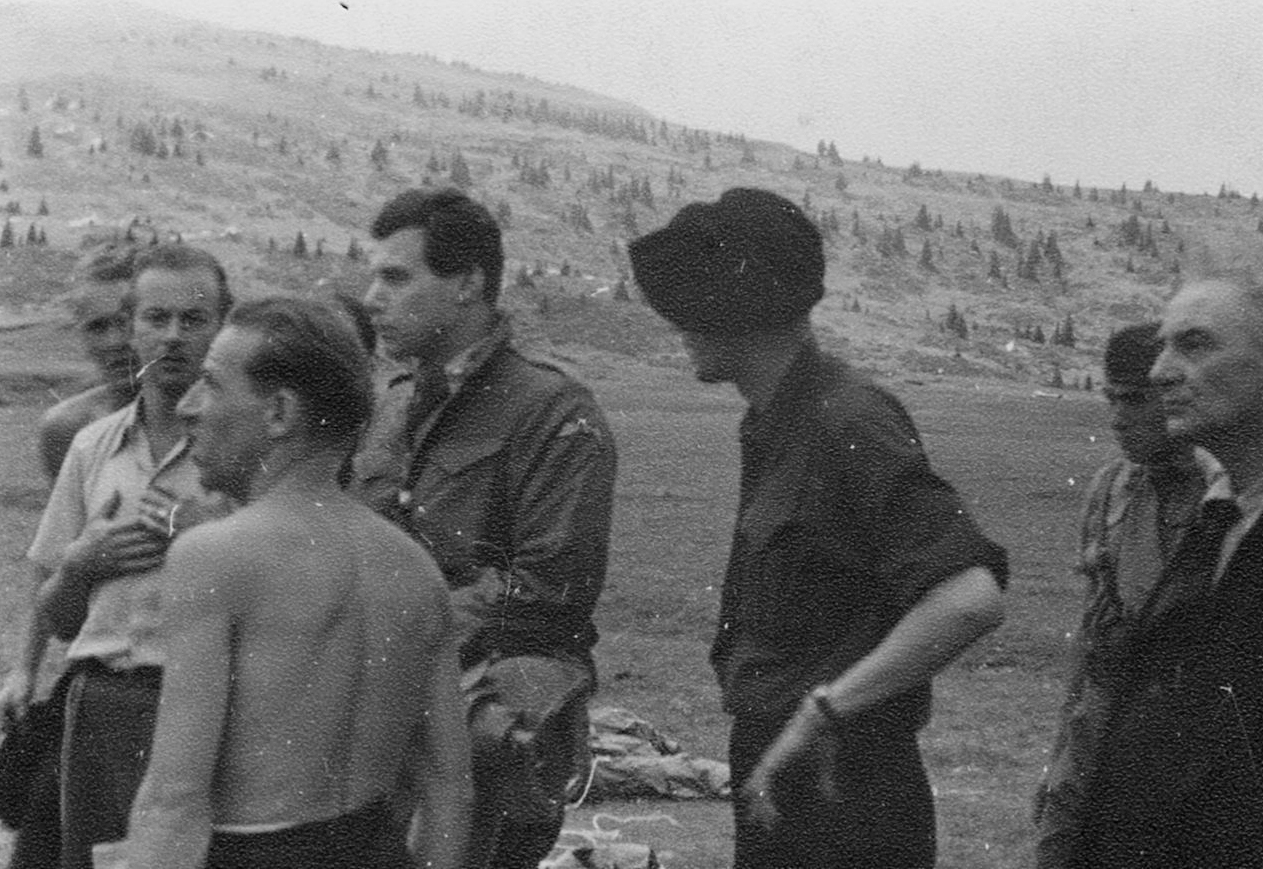
Shortly after his arrival in France in March 1944, Ortiz began working with local Maquis fighters against the occupying Germans. His OSS Special Force wing is clearly displayed on the arm of his M1943 field jacket.
Marine Corps History Division.
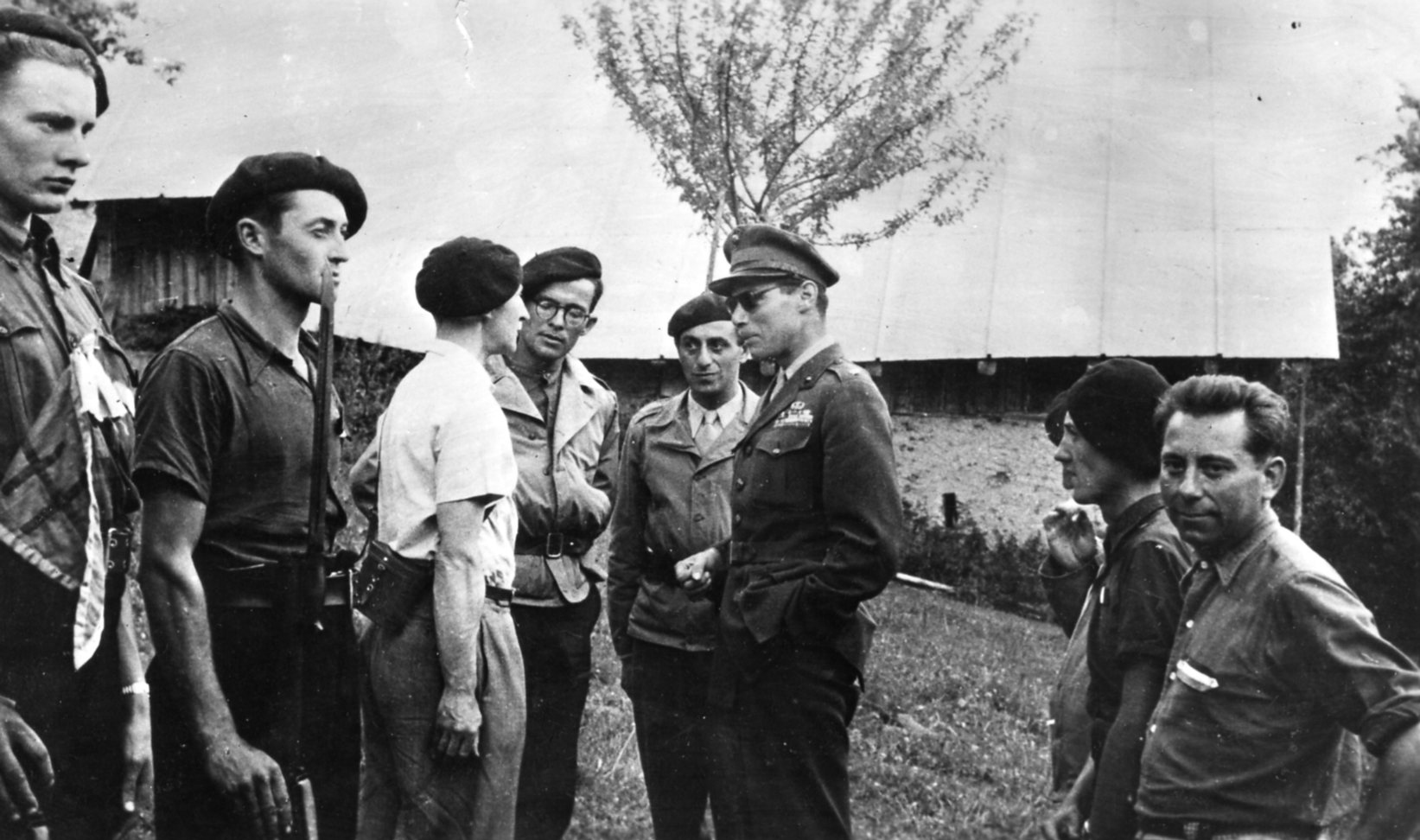
Ortiz developed a reputation for blatantly wearing his dress uniform in occupied France, almost daring the Germans to capture him.
Marine Corps History Division.
While in France, Ortiz led several Maquis hit-and-run raids on German military infrastructure, often inflicting considerable damage on the enemy forces. But participating in combat operations and training the Maquis were not his only roles. When four downed RAF aircrew were recovered by the Maquis, Ortiz volunteered to get them safely to the Spanish border, some 483 kilometers away. Not only did he successfully deliver the British fliers to freedom in Spain, but he also returned to his team just a few days later.
On 22 May 1944, the Union team was exfiltrated by airplane and brought back to the United Kingdom for debriefing and preparation for their next mission. The Allied invasion of Normandy was imminent, and the focus within the OSS headquarters in England had temporarily shifted completely to Northern France. On 6 July at OSS headquarters, U.S. Navy admiral Harold R. Stark, the commander of U.S. Naval Forces Europe, presented Ortiz with the Navy Cross for his actions as part of the Union team.
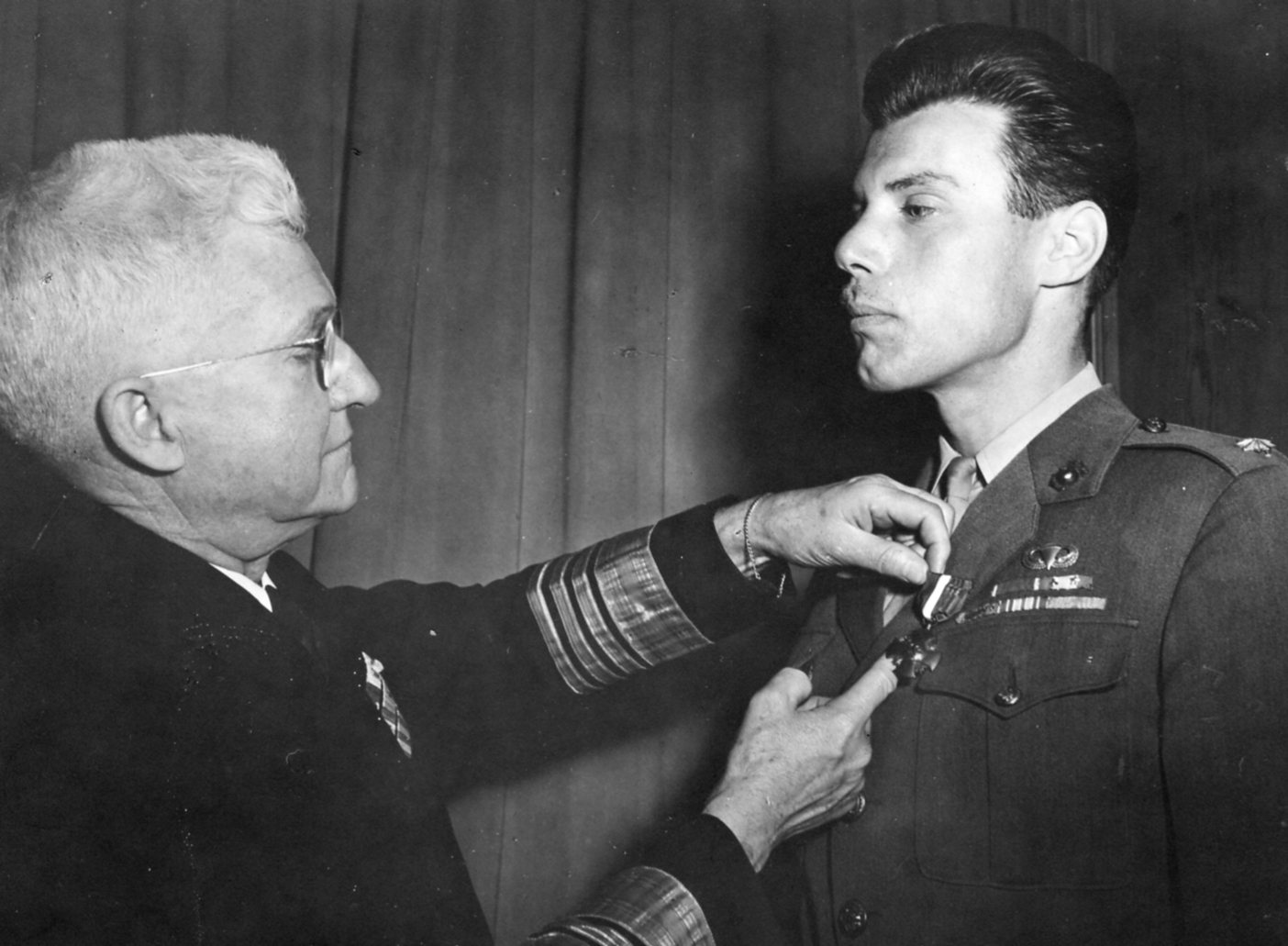
Ortiz is presented with the Navy Cross by Adm Harold R. Stark in London.
Marine Corps History Division.
Due to his familiarity with Southern France and his performance during the Union I operation, Captain Ortiz was chosen to lead a new team, codenamed Union II. This team was, in effect, the prototype for the new Operations Group teams that would follow later in the month. Instead of leading a three-person team, Ortiz had seven under his command, five of whom were Marines. A USAAF intelligence officer, Captain Francis L. Coolidge, and a Free French officer rounded out the roster. This larger team was ideal for leading direct-action raids against German targets in occupied France in the two weeks leading up to Operation Dragoon, the Allied invasion of Southern France.
The Union II team boarded a 388th Bomb Group B-17G at Knettershall Army Airfield on the evening of 1 August 1944 and took off for Southern France.[7] The mission ran into trouble almost immediately when Sergeant Charles R. Perry’s parachute failed on the jump, killing him. The remainder of the team regrouped on the ground and linked up with their French Resistance contacts.
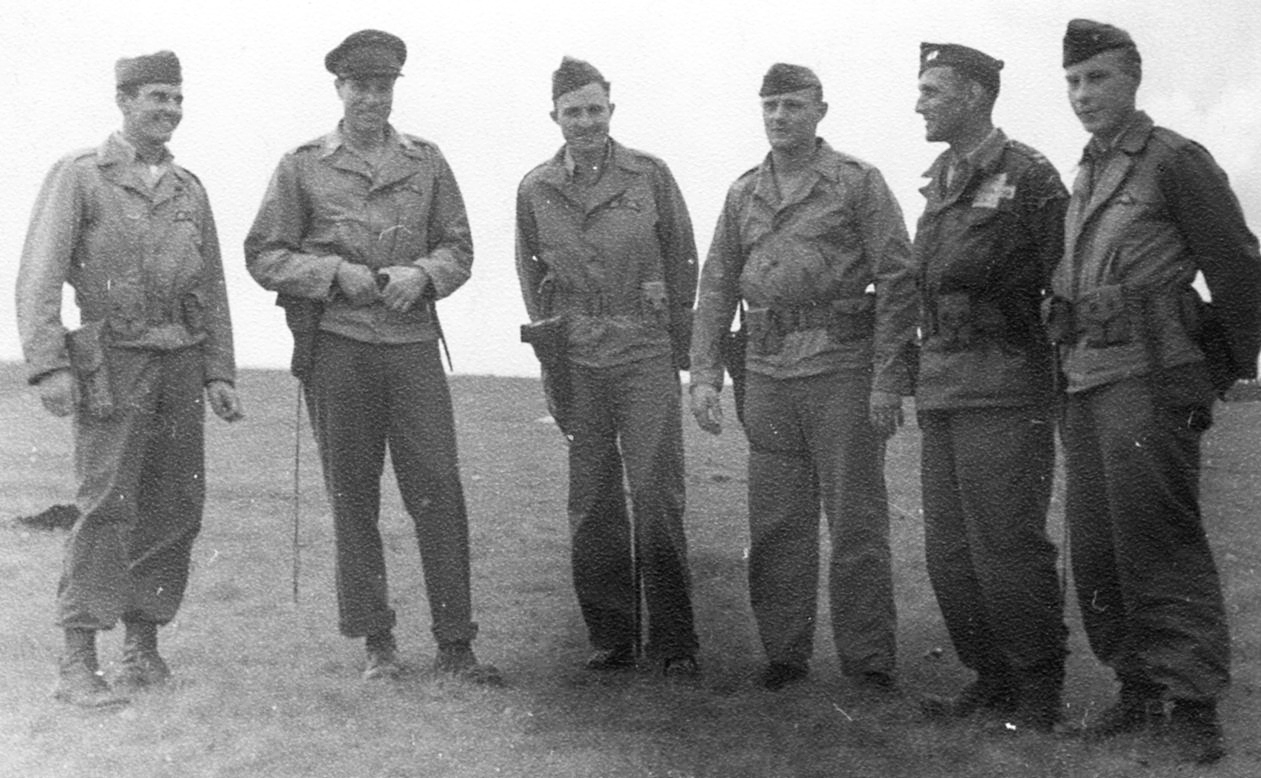
Operation Union II Team, 2 August 1944 (from left): Sgt John Bodnar, Maj Peter J. Ortiz, Sgt Robert LaSalle, Sgt Fred Brunner, Capt Frank Coolidge, and Sgt Jack Risler.
Marine Corps History Division.
The team linked up with Captain Jean Bulle, who commanded the French Resistance battalion that bore his name. While Ortiz and Bulle planned their training to arm the 3,000 Maquis fighters in the region, the 388th Bomb Group continued to fly missions over the area, dropping nearly 1,000 containers of weapons and ammunition in the ensuing two weeks. This irregular force would be critical in sowing confusion in the areas north of the invasion beaches and landing zones during Operation Dragoon.
Ortiz’s primary mission was identifying critical logistics hubs, fuel and ammunition depots, and infrastructure that could potentially support the reinforcement of the invasion beaches. During the rapid Allied advance northwards, any chaos that he and his team could sow would aid the advancing U.S. 7th Army and lessen the effectiveness of the German forces they had to face.
On 16 August, Ortiz, accompanied by Captain Coolidge, Gunnery Sergeant Robert E. LaSalle, and Sergeants John P. Bodnar, John R. Risler, and Frederick J. Brunner, attempted to sabotage the roadway between Albertville and Bourg-Saint-Maurice when they were identified and attacked by a large German force outside the town of Montgirod. The team retreated to more defensible positions, ultimately taking cover in the town of Centron. Coolidge was hit in the leg, and he and Brunner pulled back to the bank of the Isere River, where Ortiz gave them the go-ahead to cross.
Ortiz, Bodnar, and Risler continued to put up a significant fight against the Germans, moving from position to position and firing madly. It became increasingly clear that if they continue the fight, the Germans—and more specifically the Nazi Gestapo—would exact revenge reprisals on the town’s residents and burn the town to the ground. This was not an acceptable outcome to Ortiz, and so he ordered Bodnar and Risler to retreat across the river while he intended to surrender to spare the town. The two Marines refused to leave Ortiz, preferring to surrender with him than leave him behind.
The Germans were initially confused as to who was surrendering, stunned that a U.S. Marine officer and two noncommissioned officers had held up their battalion without any other support. The three Marines were taken into custody after a pledge was secured that no reprisals would fall on the town after their surrender. The Germans remained true to their word, and the Marines began the long trek to a prisoner-of-war camp in Germany. Six days later, the advance elements of the U.S. Army’s 36th Infantry Division liberated Centron.
The three Marines initially attempted to claim that they were paratroopers who had been mis-dropped during the invasion of Southern France. The ruse worked initially, but when they arrived at the headquarters of the German 157th Reserve Division, their interrogating officer knew exactly who they were and their role in aiding the Maquis. The Marines moved together to holding area in Italy and then to Austria, finally arriving at the Marinelager-Nord prisoner-of-war camp outside of the town of Westertimke in north-central Germany by mid-September. The camp primarily housed British and Canadian Royal Navy personnel and Royal Marine commandos, but there were a handful of U.S. personnel there as well. Ortiz, who became the ranking American officer there, was separated from the Bodnar and Risler, who were to be quartered with the rest of the enlisted personnel.
Eight months of captivity, attempted escapes, starvation, and hardship ended in April 1945. The prisoners at Marinelager-Nord were ordered to march south from the camp as the advancing Allies closed in. It was clear to the prisoners that the guards did not care much about keeping them together, so Ortiz and a few others were able to slip away from the main formation. After hiding out in the woods for a few days, they realized that they would be better off heading back to the camp, where they would at least have some shelter from the elements.
British forces liberated Marinelager-Nord on 27 April 1945. Ortiz, Bodnar, and Risler requested to join the liberating unit of Royal Marine commandos to get back into the fight. Because of their weakened condition, they were refused and sent back to the United Kingdom and freedom.
After returning to England, now-Major Ortiz underwent an extensive debriefing on his prisoner-of-war experience and his overall experience as an OSS officer in Europe during the war. His evaluation listed him as:
An aggressive, alert, energetic and highly competent field officer who has led a life of romantic adventure the past 14 years. Coming from a privileged but broken home, he never acquired the conventional standards of this culture. A childhood spent in travel both in the United States and abroad accustomed him to change and excitement. Six years in the Foreign Legion whetted his thirst for adventure which 6 years of service in this war have not quenched. He already holds the Navy Cross and minor decorations and is the type who will win more. He views difficulties as a challenge which add spice to his job. He is dynamic and an excellent field leader. He is highly recommended for an SO field mission but is not regarded as a good candidate ever for a desk assignment.[8]
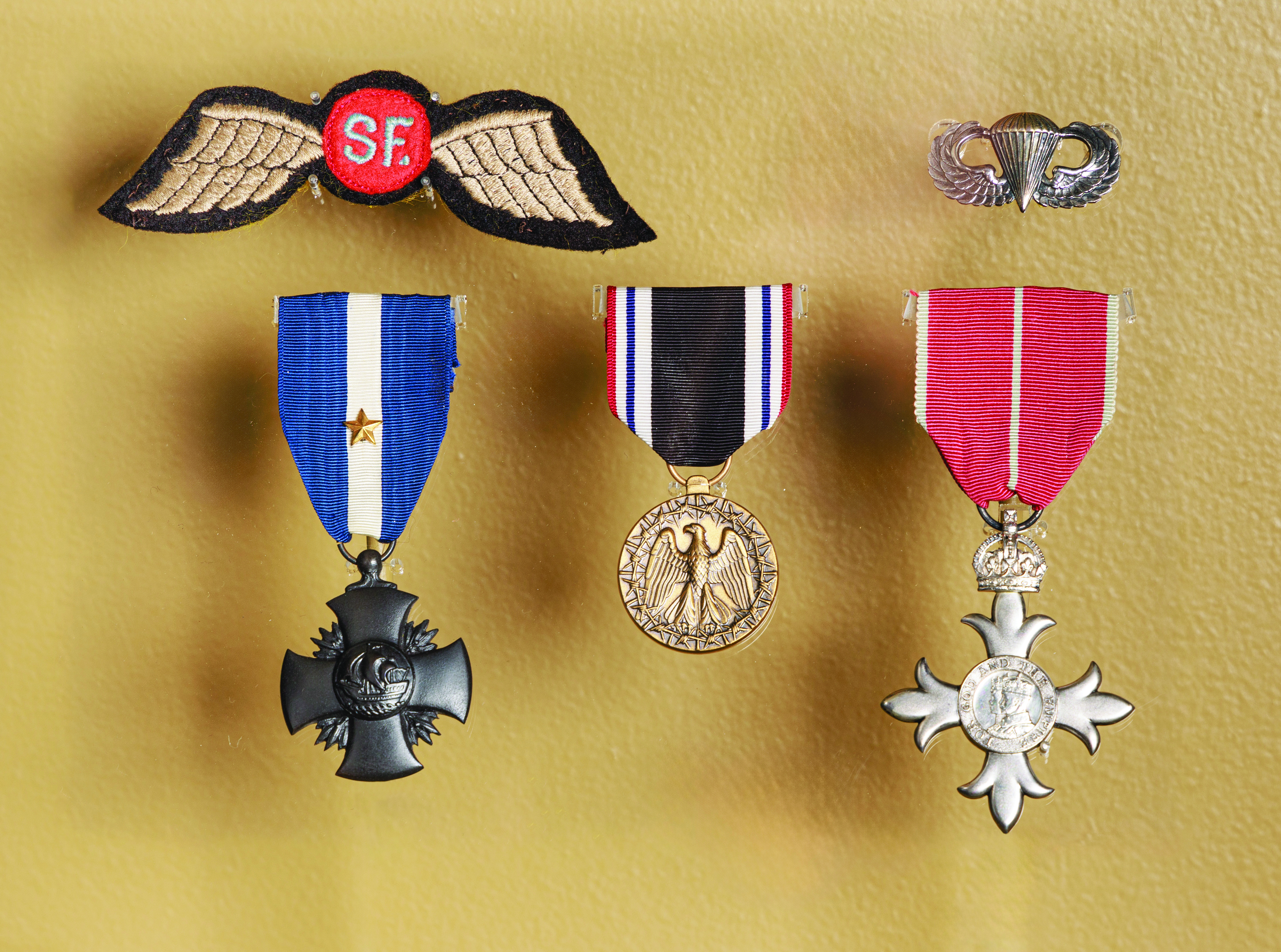
Col Ortiz’s Navy Cross with Gold Star in lieu of a second award is currently on exhibit at the National Museum of the Marine Corps alongside his Prisoner of War Medal and his Member of the Order of the British Empire Medal. Already an accomplished parachutist by the time he joined the OSS, Ortiz also earned both the Army parachutist wings and the OSS’s coveted Special Force wing.
Photo by Jose Esquilin, Marine Corps University Press.
During his debrief, Ortiz requested to be dropped into French Indochina as his next field assignment, a plan endorsed by Gerald E. Miller, the chief of the OSS Special Operations Division. He also requested to keep his team of OSS Marines together, which Miller too endorsed. Interestingly, in his 1 June 1945 letter to OSS headquarters, Miller made it clear that Ortiz would need a clearly defined mission in Southeast Asia, stating that “I wish to accent the point that he must be given an active and specific mission. Being a person of vast energy, extremely capable and courageous, it almost necessarily follows that he is a restless individual and if forced to remain static after arriving in the theater, will not react very favorably.”[9]
By the end of June, the OSS Special Operations branch initiated Ortiz and his team’s transfer from the European theater of war to China, and they began preparations for a new mission against the Japanese. However, the war was rapidly ending in the Pacific. The Japanese Empire surrendered to the Allies on 15 August 1945, leaving Ortiz and his team without a mission. By 4 September, the OSS released Ortiz back to the Marine Corps Reserve, where he was assigned to the General Service Unit, 11th Reserve District in San Diego, California.
In January 1946, Ortiz’s second Navy Cross finally caught up with him. With his recent separation from active duty, there was no formal presentation, but the citation reads:
The President of the United States of America takes pleasure in presenting a Gold Star in lieu of a Second Award of the Navy Cross to Major Pierre (Peter) J. Ortiz (MCSN: 0-12779), United States Marine Corps Reserve, for extraordinary heroism while serving with the Office of Strategic Services during operations behind enemy Axis lines in the Savoie Department of France, from 1 August 1944, to 27 April 1945. After parachuting into a region where his activities had made him an object of intensive search by the Gestapo, Major Ortiz valiantly continued his work in coordinating and leading resistance groups in that section. When he and his team were attacked and surrounded during a special mission designed to immobilize enemy reinforcements stationed in that area, he disregarded the possibility of escape and, in an effort to spare villagers severe reprisals by the Gestapo, surrendered to this sadistic Geheim Staats Polizei. Subsequently imprisoned and subjected to numerous interrogations, he divulged nothing, and the story of this intrepid Marine Major and his team became a brilliant legend in that section of France where acts of bravery were considered commonplace. By his outstanding loyalty and self-sacrificing devotion to duty, Major Ortiz contributed materially to the success of operations against a relentless enemy and upheld the highest traditions of the United States Naval Service.
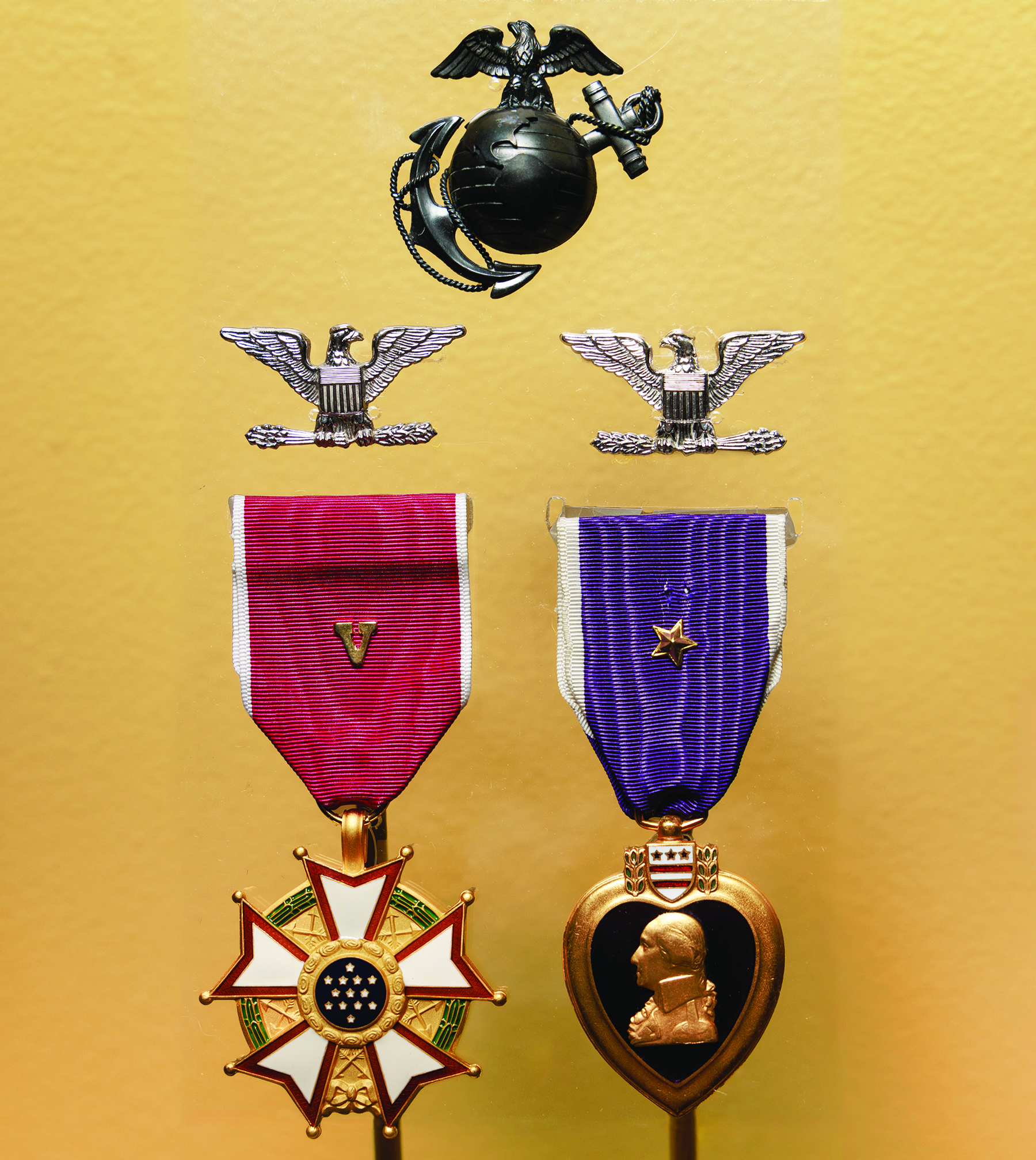
Col Ortiz’s Eagle, Globe, and Anchor, colonel’s rank eagles, and Legion of Merit and Purple Heart with Gold Star medals. Ortiz was wounded in combat twice while serving in the OSS, once in North Africa and once in France.
Photo by Jose Esquilin, Marine Corps University Press.
With the war over and the thrill of combat behind him, Ortiz turned his attention back to Hollywood to focus on technical advising on military matters. From 1947 to 1957, Ortiz acted in and advised on 29 films and television episodes, often playing small roles and serving as the on-set military technical advisor. He appeared in Twelve O’clock High (1949) with Gregory Peck; Scirocco (1951) with Humphrey Bogart, Abbott and Costello in the Foreign Legion (1950) with the comedic duo; and Rio Grande (1950) and Flying Leathernecks (1951) with John Wayne.
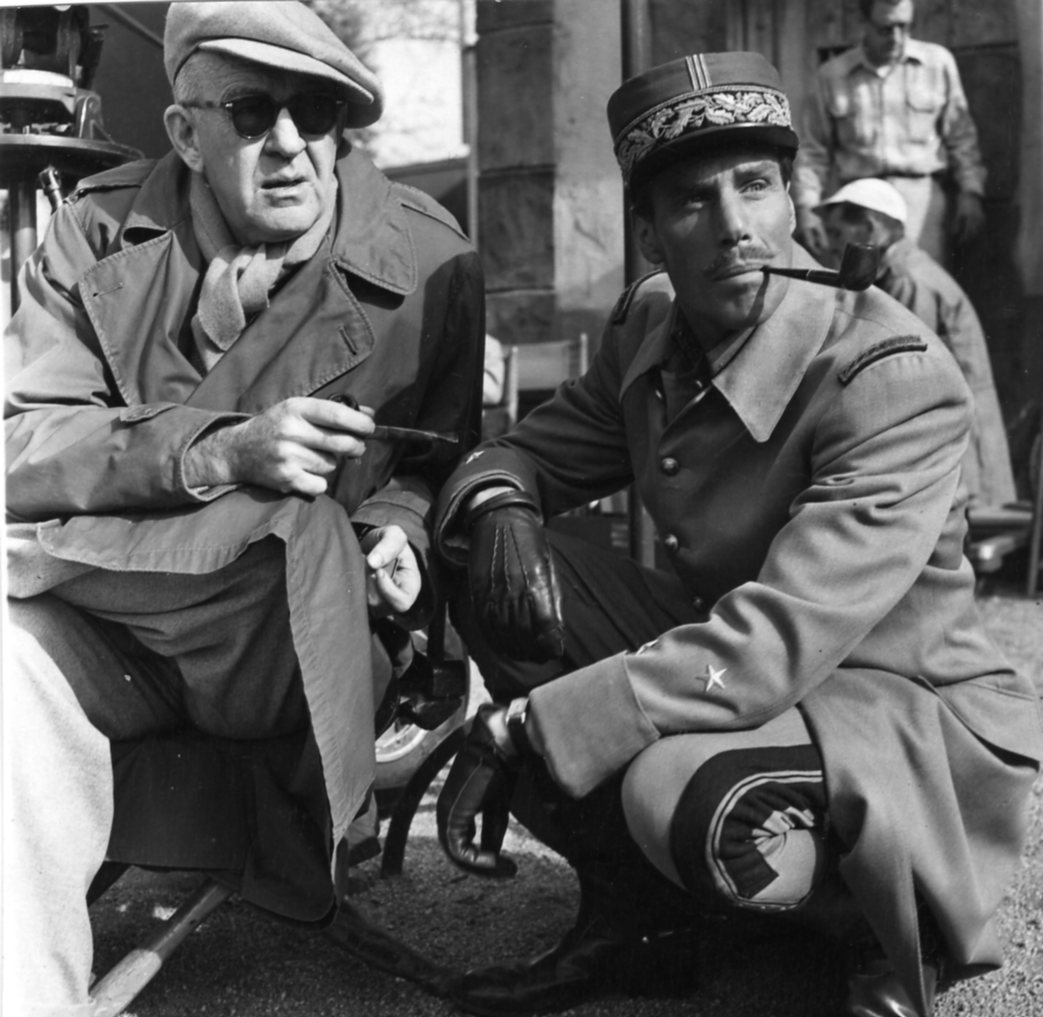
Ortiz and director John Ford worked together on a number of occasions. Both had served in the OSS during the war, which became the foundation for an enduring friendship.
Marine Corps History Division.
Word of Ortiz’s experiences in World War II traveled quickly around Hollywood. The film 13 Rue Madeleine (1947) was loosely based on his exploits and benefited greatly from his technical advising. Four years later, Ortiz was again approached to make a film on his time in Europe, and this time he would be a part of the scriptwriting team. The film Operation Secret (1952) was intended to be directly inspired by his OSS exploits, but as the project commenced, it was clear that the production team had other intentions. “They had stipulated that I was to help in the screenplay, but [they] never consulted me,” Ortiz told reporter Bob Thomas from the Newport Daily News. “They did a lot of things I didn’t particularly approve of, but on the other hand they did some things that I thought were good.”[10]
Ortiz remained in the Marine Corps Reserve through the early 1950s. He was promoted to lieutenant colonel in late 1951 and moved to the Inactive Reserve rolls by early 1953. Ortiz retired from the Marine Corps in 1955 and was promoted to colonel after his retirement.
Endnotes
[1] “11th Foreign Infantry Regiment,” French Foreign Legion Information, 7 November 2019.
[2] “Peter Ortiz” (Biographical Files, Marine Corps History Division, Quantico, VA), hereafter Ortiz Biography.
[3] Benis M. Frank, “Colonel Peter Julien Ortiz: OSS Marine, Actor, Californian,” California State Military History and Museums Program, 1996; and Ortiz Biography.
[4] Frank, “Colonel Peter Julien Ortiz.”
[5] “Special Operations,” Office of Strategic Services, accessed 7 May 2024.
[6] No. 138 Squadron: Operations Record Book, 1941–1945 (National Archives, Kew, Richmond, UK), 124.
[7] Maj Robert E. Mattingly, Herringbone Cloak—GI Dagger: Marines of the OSS (Washington, DC: History and Museums Division, Headquarters Marine Corps, 1989), 118.
[8] OSS Debrief Form 2725, May 1945, USMC History Division Biographical Files: Peter Ortiz.
[9] Correspondence between Gerald Miller (Chief, Special Operations Branch and Capt Harrison Barrow, OSS Special Operations Area Officer), 1 June 1945, USMC History Division Biographical Files: Peter Ortiz.
[10] Bob Thomas, “Peter Ortiz: One Actor Whose Life Reads like Motion Picture Thriller,” Newport (RI) Daily News, 20 April 1953, 11.